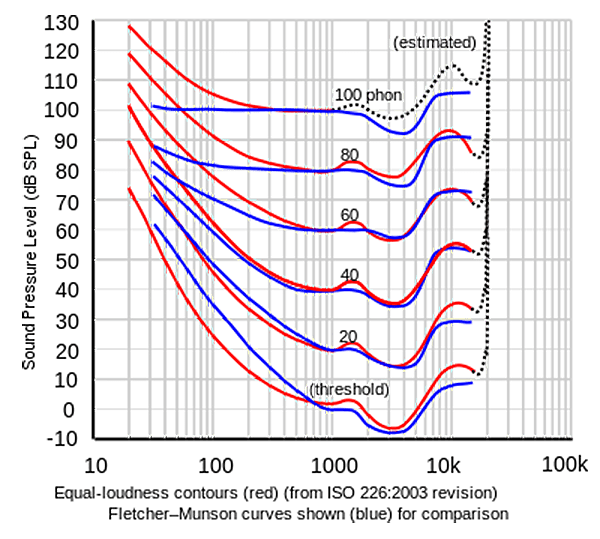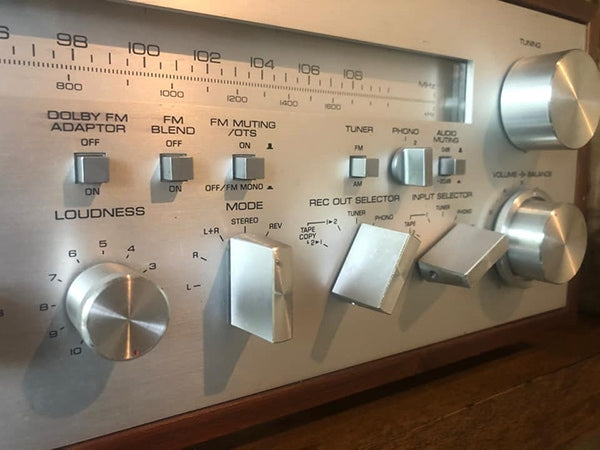Component audio systems were still comparatively rare when my college roommates and I put one together (see my article in Issue 149), but there was at least one other in our dormitory. Two flights below us, my friend Skip had a simple mono system consisting of a big Klipschorn, a 10-watt integrated amp, and a turntable (possibly a 45-only changer like my first turntable).
I was still new to audio components, so I took a close look at the amp’s control panel. it had a source selector switch of course, plus bass and treble controls, a volume knob, and another labeled “Loudness.” Volume and loudness? Weren’t those both the same thing?
Skip’s explanation, if he gave one, went right over my audio-newbie head. But I do recall him saying that it added bass.
But why, if there was already a bass control? “Well,” said Skip, “I like a lot of bass. That’s why I got the Klipschorn, for starters. But to get the bass I like, I start with 45rpm records that have heavy jukebox bass. And though the turntable I play them on has a ceramic cartridge, I feed it into the magnetic phono input, because the RIAA equalization boosts the bass,” (that much, I understood), “and I turn the bass control all the way up, and then I set the loudness control for maximum bass boost.”
I still wondered why his amp had two controls that boosted bass, and why one was labeled “Loudness.” But then he turned the system on, and I just listened. Even with just 10 watts, Klipschorns can play very loud. And there sure was a lot of bass! I could no longer hear Skip’s system when I went back to my room, two flights above, but I could swear that, standing in my stocking feet, I could just about discern the beat. And I began wondering about that knob again…
I’d have wondered less if the knob had been labeled properly – not “loudness,” but “loudness compensation.” It compensated for the way our hearing system’s frequency response changes with sound level. Make a sound softer and it seems to lose some bass and a smidgen of treble. Those frequencies are still there, but we no longer hear them as well.
We don’t notice this when the music itself gets softer, because we’re used to the difference in sound between a forte and a pianissimo. But if we’re listening to loud music at soft levels, as we often do at home, the sound is noticeably thinner and may lose some of its sparkle.
This is often called the Fletcher-Munson Effect, after the two Bell Labs researchers who first measured it. In 1933, they published a set of “equal-loudness contour” curves showing, for sound pressure levels (SPL) from 0 to 120 dB, what amount of boost (and, sometimes, cut) would be needed to make tones at various frequencies sound as loud as a 1-kHz tone. These curves have been revised a few times since [1], by others, but they all show basically the same thing.
 Fletcher-Munson curves. Note that before frequency was referred to as "Hertz," it was given in cycles per second.
Fletcher-Munson curves. Note that before frequency was referred to as "Hertz," it was given in cycles per second.To counteract this effect, a loudness compensation circuit modifies the signal as you turn your volume control down, lowering the volume less in the bass and upper treble than at mid-frequencies. Today, that’s usually controlled by a simple switch rather than a knob, though I’ve seen fairly recent gear from Yamaha, Marantz, and others with loudness knobs.
Loudness switches are less confusing and expensive than variable loudness-compensation knobs and they do help restore a natural fullness to the sound, adding compensation as the volume is turned down. But variable loudness controls offer greater precision and accuracy, because the position of the volume knob is far from the only factor governing how much compensation is needed.
Proper compensation varies with both the sound level of the original performance and the difference between that and the sound level reaching your ears at home. According to the Fletcher-Munson curve [2], reducing the volume 30 dB would require about 8 dB of boost at 100 Hz for sonic accuracy if the performance’s sound level was 100 dB SPL – but would require about 25 dB of boost if the performers had been playing at 70 dB SPL.
 ISO 2003 loudness curves, compared to the Fletcher-Munson curves.
ISO 2003 loudness curves, compared to the Fletcher-Munson curves.
So, the first factor that loudness compensation must take into account is the recording or broadcast you’re listening to. How loudly were the performers playing? And how much headroom did the recording and mastering engineers leave between the loudest recorded note and the point at which the signal would become distorted? And how are these affected by the output levels from your phono cartridge, CD player, or streaming device? The amplifier’s designer can only guess.
That designer will at least know your amp’s input sensitivity, its gain for every volume setting, and its output power – but not the sensitivity of your loudspeakers. Skip’s 10-watt amp could deliver a lot of sound from Klipschorns, which were and are among the most efficient speakers ever [3], but the results using acoustic-suspension speakers like the then-new AR-3 [4] would have been much quieter.
The room’s acoustics are another variable. Sound levels in a large room with a lot of carpets and upholstered furniture will be lower than in a small room with fewer soft surfaces.
For an amplifier with a simple loudness switch, a designer will calibrate the compensation circuit for average recordings, played through a speaker of average sensitivity, in an average room. That will satisfy most listeners, because few pay close attention to the sound in background listening. But if the designer wants his amplifier’s loudness compensation to be really accurate, he’ll give it a knob that lets you adjust it for this recording, over your system, in your room.
How do you set that knob? According to both a Yamaha manual I found online, and an article I wrote in 1965, you adjust such controls by raising the volume to the highest level you expect to listen at, then you use the loudness knob like a volume control. That fits with my recollections of Skip’s amp, whose volume and loudness knobs were both the same size.
But I’ve also heard that you should play music at normal volume, then turn the volume down and adjust the loudness compensation until the frequency balance sounds the same as it did before you changed the volume setting. After that, leave the loudness knob alone, because you’ve now set loudness compensation for the variables in your room and system (at least for one of your signal sources) – the next time you’ll need to touch that knob is when you change your room’s furnishings or your system’s components. That fits with the fact that loudness knobs on modern amps I’ve seen are usually much smaller than volume controls.
I don’t really know which version is correct, but I’ll bet someone who does will soon tell us in the Comments.
Even if Skip’s still listening, I doubt he’ll care. Though his amp’s loudness control was meant to preserve realism, he joyfully perverted it to give him the unreality he wanted – fun over fidelity. And nowadays, he’d have a better way to make his walls rock: subwoofers.
[1] In 1957, D.W. Robinson and R.S. Dadson, of Britain’s National Physics Laboratory, produced a new set of curves, which became an ISO standard 30 years later. That standard was revised in 2003
[2] Chosen here because it’s the simplest curve, and easiest to read.
[3] Rated 105 dB SPL for 1 watt at 1 meter, though 1959 models might have been a bit different.
[4] I don’t think AR published a sensitivity spec, but I’ve seen it quoted as 83 dB, which means it would have taken about 100x as much power as the Klipsch to achieve the same output.
Header image: the variable loudness knob on a Yamaha receiver.



